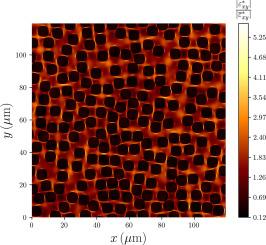各向异性碳纤维增强热塑性塑料的线性粘弹性:从微观力学到动态扭转实验
IF 12.7
1区 材料科学
Q1 ENGINEERING, MULTIDISCIPLINARY
引用次数: 0
摘要
通过微观力学建模探讨了各向异性线性粘弹性单向碳纤维增强热塑性复合材料的实验表征与构成行为之间的联系。在广泛的温度范围内,从聚合物基体的玻璃态到橡胶态,对纯基体和复合材料进行了 1 Hz 的动态扭转试验,并对纤维进行了不同角度的切割。为预测和验证复合材料的有效行为,提出了一个分两步的频域建模程序。第一步是基于 FFT 的均质化,将微观结构和成分行为映射为有效的横向各向同性粘弹特性。第二步是使用均质化计算出的有效行为作为输入进行有限元模拟,以复制实验结果。对整个温度范围内的实验结果和模型预测结果进行了比较。模型预测在基体处于玻璃态的低温下显示出良好的准确性。在高温下,基体处于橡胶状态,预测行为变得过于软弱。随着相位对比度的增加以及基体体积模量与剪切模量之比的显著上升,纤维排列对有效特性的影响变得更加明显。本文章由计算机程序翻译,如有差异,请以英文原文为准。

Linear viscoelasticity of anisotropic carbon fibers reinforced thermoplastics: From micromechanics to dynamic torsion experiments
The link between experimental characterization and the constitutive behavior of an anisotropic linear viscoelastic unidirectional carbon fiber-reinforced thermoplastic composite is explored using micromechanics modeling. Dynamic torsion tests were conducted at 1 Hz over a wide temperature range, from the glassy to the rubbery states of the polymeric matrix, on both the pure matrix and the composite, for various cutting angles relative to the fibers. A two-step modeling procedure in the frequency domain is presented to predict and validate the effective behavior of the composite. The first step involves FFT-based homogenization, which maps the microstructure and constituent behaviors to effective transversely isotropic viscoelastic properties. The second step consists of finite element simulations using the effective behavior calculated from homogenization as input to replicate the experiments. A comparison between experimental results and model predictions across the entire temperature range is performed. The modeling predictions show good accuracy at low temperatures, where the matrix is in the glassy state. At high temperatures, where the matrix is in the rubbery state, the predicted behavior becomes too soft. As the phase contrast increases and the ratio of matrix bulk modulus to shear modulus rises significantly, the impact of fiber arrangement on the effective properties becomes more pronounced.
求助全文
通过发布文献求助,成功后即可免费获取论文全文。
去求助
来源期刊

Composites Part B: Engineering
工程技术-材料科学:复合
CiteScore
24.40
自引率
11.50%
发文量
784
审稿时长
21 days
期刊介绍:
Composites Part B: Engineering is a journal that publishes impactful research of high quality on composite materials. This research is supported by fundamental mechanics and materials science and engineering approaches. The targeted research can cover a wide range of length scales, ranging from nano to micro and meso, and even to the full product and structure level. The journal specifically focuses on engineering applications that involve high performance composites. These applications can range from low volume and high cost to high volume and low cost composite development.
The main goal of the journal is to provide a platform for the prompt publication of original and high quality research. The emphasis is on design, development, modeling, validation, and manufacturing of engineering details and concepts. The journal welcomes both basic research papers and proposals for review articles. Authors are encouraged to address challenges across various application areas. These areas include, but are not limited to, aerospace, automotive, and other surface transportation. The journal also covers energy-related applications, with a focus on renewable energy. Other application areas include infrastructure, off-shore and maritime projects, health care technology, and recreational products.
 求助内容:
求助内容: 应助结果提醒方式:
应助结果提醒方式:


